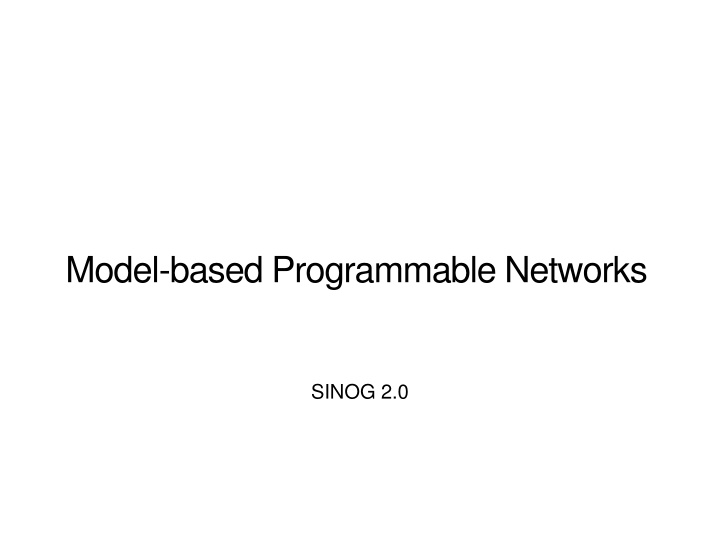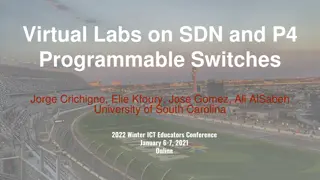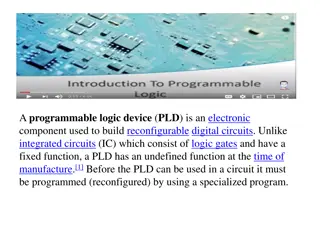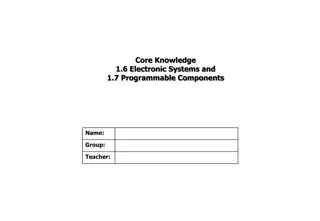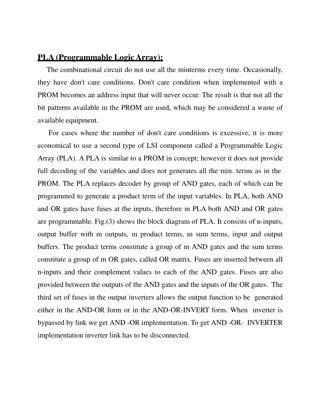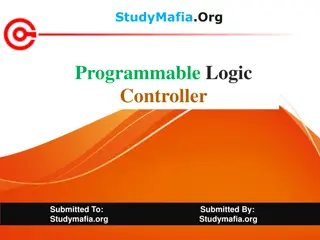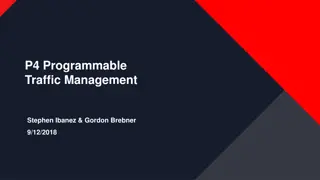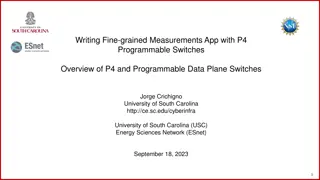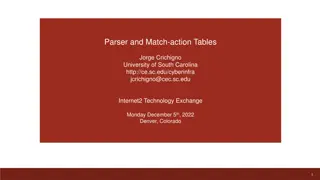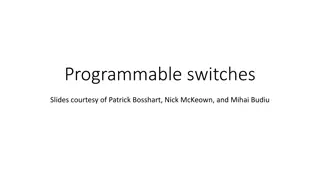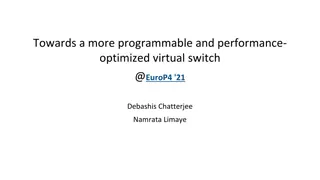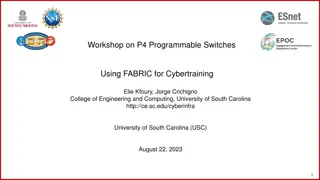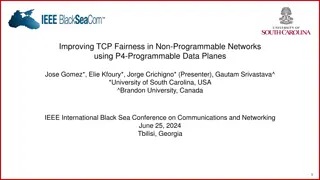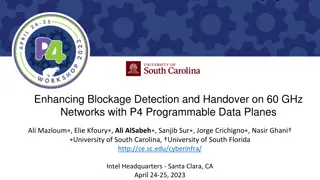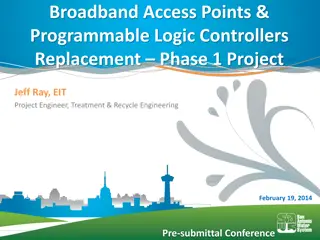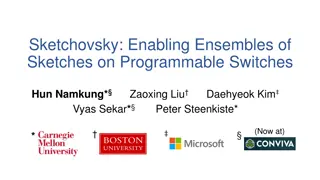Model-based Programmable Networks SINOG 2.0 Applications and Networks
Scope of Model-based Programmable Networks SINOG 2.0 focusing on applications and networks routing system players, interdependent entities, layers, and evolving concepts in different SDOs. Delving into I2RS working group deliverables in IETF, emphasizing routing control plane over data plane, operational models, and provisioning mechanisms like CLI, SNMP, and NETCONF.
Download Presentation

Please find below an Image/Link to download the presentation.
The content on the website is provided AS IS for your information and personal use only. It may not be sold, licensed, or shared on other websites without obtaining consent from the author.If you encounter any issues during the download, it is possible that the publisher has removed the file from their server.
You are allowed to download the files provided on this website for personal or commercial use, subject to the condition that they are used lawfully. All files are the property of their respective owners.
The content on the website is provided AS IS for your information and personal use only. It may not be sold, licensed, or shared on other websites without obtaining consent from the author.
E N D
Presentation Transcript
Model-based Programmable Networks SINOG 2.0
Applications and Networks Routing system players: the Application and the Network. Different interdependent entities and layers Application as seen from Network: it is a payload Network as seen from Application: it is a dumb pipe Application needs Network visibility Network needs Application awareness The topic is rapidly evolving and may be controversial There are multiple concepts in different stages of development in various SDOs. The focus of this talk is on I2RS working group deliverables in IETF.
Scope It is about routing control plane Not about forwarding data plane A router is not necessary an application hosting platform Running routing protocol adjacency to an application is not necessary practical Reuse existing operational model
Current Operational Model CLI and SNMP are dominant provisioning (configuration) mechanisms NETCONF is gaining traction as a new provisioning mechanism But not everyting is a configuration state may need to be modified dynamically and not stay persistent Operational state and statistics need to be exported
Interfaces and Models Two components signalling protocol and data model Bits on the wire, encoding, messaging, state transfer Description of entities and their attributes Model can abstract services too, not only elements
Forwarding and Platform Aspects Reuse existing platforms do not touch data plane Export visibility of data plane operations and events Protocol-RIB -> RIB -> FIB model stays the same Protocol-RIB changes are (mostly) local RIB changes are local No direct changes to FIB
Network Element Model I2RS Interface OSPF Control Plane I2RS Agent BGP BGP-RIB OSPF-RIB RIB Statistics Statistics Data Plane Interface FIB Interface
Network Model Clients interact with agents, client to client communication is out of scope of I2RS architecture I2RS Client I2RS Client Agent Agent Agent NE NE NE
I2RS Operational Model Assumptions Try to reuse existing operational model Collect and export topology data Do the application logic part Push state into RIBs Let platform do the FIB part Feed events back to application Control plane is still there and likely unchanged
Use Cases RIB modifications BGP policy augmentation Exit path selection Topology aware applications Protection DDoS Dynamic overlay topologies Centralised control plane operations Transport aware routing decisions Asynchronous notifications from network layers OAM automation Composite link operation Dynamic anycast
Use Case IXP Data Plane Liveness In an IXP environment with route server, BGP sessions do not follow the same data plane path as traffic between a pair of IXP peers. Tracking BGP session data plane liveness is not enough. Received UPDATE contains new NH attribute If path is selected for use, asynchronously notify OAM/data plane liveless component Start OAM/data plane liveness session to specified NH node Typically solved via configuration automation today, I2RS allows for protocol level automation
Use Case Failure Notification IGP propagates topology changes sequentially neighbor to neighbor, each such hop adds up to the total convergence time. The egress node adjacent to failure exports a "Prefix unreachable" event to I2RS client which gets directly propagated to ingress node. Ingress node removes affected prefix from RIB and this may trigger restoration process. Can be solved via (centralized) event collection today. I2RS Agent Failure Indication NE1 NE2 NE3 NE4 NE5
Use Case BGP Policy Augmentation Influence BGP best path decision process based on criteria external to BGP attributes Per-client custom reflector views Centralized attribute management Export BGP and BGP-RIB events new peer, new prefix, change of NH, change of community Signal interest to (BGP)-RIB to track state of certain prefixes Precomputed BGP RIB download, actual BGP decision proces is no longer local.
Use Case Network Topology Export Export information about particular routing protocol topology view without running protocol adjacency to the application Export information about RIB topology (similar to TE topology but for routing information only) Exported information is implicitly correlated to inventory and operational state Potentially in the future topology could be modified via I2RS mechanism too
Use Case Dynamic Transport Large flow transport layer optimization Detect large flows by any practical means Lookup flow to forwarding association mapping Export flow mapping to transport layer Typically solved by offline capacity planning or automation
The Components The overall concept relies on defining a data model of the information that can be exported and imported, and a protocol between I2RS agent and I2RS client Protocol part is relatively easy. Data model and modelling language is the harder part. Both are needed and are interrelated.
The Components NETCONF seems to be a growing trend in network element configuration. Naturally it is tempting to reuse it as much as possible. NETCONF is inherently tied to configuration, and not so much to operational state that does not have underlying configuration, therefore extensions will be needed. NETCONF itself and the underlying transport might be too heavy for frequent bulk state modifications. RESTCONF seems to be somewhat lighter solution. YANG with extentsions is a candidate for data modelling language. This is an ongoing discussion in the working group at the moment.
Configuration and Operational State State received via I2RS interface complements operational state derived from local configuration. NETCONF SNMP I2RS Local Config Local Config I2RS State Operational State
Persistence and Propagation of I2RS State I2RS state is defined to be ephemeral, it is not saved into configuration. There is no 1:1 correlation between ephemeral state and configuration state. Ephemeral state is injected over I2RS protocol (not yet defined), configuration state is provisioned over NETCONF (or something else not in scope in this context). I2RS state can be propagated to other network elements via normal control plane operation (if injected prefix is considered to be the best, BGP will propagate it to other peers).
Discussion Ideas on the topic have been floating around in the IETF for a couple of years IETF needs community feedback Both on architecture and on use cases Let's talk
